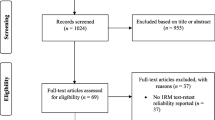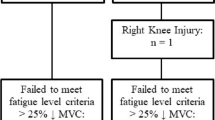Summary
To investigate the relative activation of the synergistic muscles during three different types of muscle contraction, the electromyograms (EMG) of two elbow flexor muscles, the biceps brachii (BB) and the brachioradialis (BR), have been compared. To accomplish this eight healthy human subjects performed the following elbow flexions against the same load — concentric, eccentric and isometric contractions. The isometric contractions were performed at three elbow angles: 10, 45 and 90° (0° equal to full expension). The EMG were recorded by bipolar surface electrodes, and the relative activation between the two muscles was evaluated as the quotient of mean EMG activities (BR/BB). For the isotonic elbow flexions, BR/BB were calculated at three angle divisions: 0–30°, 30–60° and 60–90°. Results indicated that the relative activation of the BR during the concentric contractions was higher than that of the eccentric contraction, particularly at the extended elbow angles, i.e. the BR/BB of the concentric contractions for the elbow joint angles ranging from 0–30° and 30–60° were significantly greater (P<0.05) than those of the eccentric contractions. During the isometric and eccentric contractions, the BR/BB at the flexed joint angles tended to be greater than those at the extended angles. In contrast, there were no angle-dependent BR/BB variations during the concentric elbow flexions. Further, changing patterns in the EMG power spectra due to the type of contraction were different between BB and BR. These results indicated that the activation pattern in the two elbow flexor muscles varied with the muscle contraction pattern.
Similar content being viewed by others

References
Akaike H (1969) Statistical predictor identification. Ann Inst Stat Math 21:203–217
Bouisset S (1973) EMG and muscle force in normal motor activities. In: Desmedt JE (ed) New developments in electromyography and clinical neurophysiology. Karger, Basel, pp 547–583
Buchanan TS, Almdale DPJ, Lewis JL, Rymer WZ (1986) Characteristics of synergic relations during isometric contractions of human elbow muscles. J Neurophysiol 56:1225–1241
Buchanen TS, Rovai GP, Rymer WZ (1989) Strategies for muscle activation during isometric torque generation at the human elbow. J Neurophysiol 62:1201–1212
Burke RE (1981) Motor units: anatomy, physiology and functional organization. In: Brooks VB (ed) Handbook of physiology, the nervous system, I–II. American Physiological Society, Bethesda, Md., pp 345–442
Burke RE, Jankowska E, Ten Gruggencate G (1970) A comparison of peripheral and rubrospinal synaptic input to slow and fast twitch motor units of triceps surae. J Physiol 207:709–732
Capaday C, Stein RB (1987) Difference in the amplitude of human soleus H-reflex during walking and running. J Physiol 392:513–522
Dietz V, Horstmann GA, Berger W (1989) Interlimb coordination of leg-muscle activation during perturbation of stance in humans. J Neurophysiol 62:680–693
Gardiner KR, Gardiner PF, Edgerton VR (1982) Guinea pig soleus and gastrocnemius electromyograms at varying speeds, grades, and loads. J Appl Physiol 52:451–457
Hodgson JA (1983) The relationship between soleus and gastrocnemius activity in conscious cats — a model for motor unit recruitment. J Physiol 337:553–562
Howard JD, Hoit JD, Enoka RM, Hasan Z (1988) Relative activation of two human elbow flexors under isometric conditions: a cautionary note concerning flexor equivalence. Exp Brain Res 62:199–202
Hutchison DL, Roy RR, Hodgson JA, Edgerton VR (1989) EMG amplitude relations between the rat soleus and medial gastrocnemius during various motor tasks. Brain Res 502:233–244
Johnson MA, Polgar J, Weightman D, Appleton D (1973) Data on the distribution of fibre types in thirty-six human muscles: an autopsy study. J Neurol Sci 42:41–50
Kwanty E, Bauer D, Kwanty HG (1970) An application of signal processing techniques to the study of myoelectric signals. IEEE Trans Biomed Eng 17:303–312
Moritani T, Muramatsu S, Muro M (1988) Activity of motor units during concentric and eccentric contractions. Am J Phys Med 66:338–350
Nardone A, Schieppati M (1988) Shift of activity from slow to fast muscle during voluntary lengthening contractions of the triceps surae muscles in humans. J Physiol 395:363–381
Nardone A, Romano C, Schieppati M (1989) Selective recruitment of high-threshold human motor units during voluntary isotonic lengthening of active muscles. J Physiol 409:451–471
Preston JB, Whitlock DG (1963) A comparison of motor cortex effects on slow and fast muscle innervations in the monkey. Exp Neurol 7:327–341
Tax AAM, Denier van der Gon JJ, Erkelens CJ (1990) Differences in coordination of elbow flexor muscles in force tasks and in movement tasks. Exp Brain Res 81:567–572
van Zuylen EJ, van Velzen A, Denier van der Gon JJ (1988a) Coordination and inhomogeneous activation of human arm muscles during isometric torques. J Neurophysiol 60–5:1523–1548
van Zuylen EJ, van Velzen A, Denier van der Gon JJ (1988b) A biomechanical model for flexion torques of human arm muscles as a function of elbow angle. J Biomech 21:183–190
Author information
Authors and Affiliations
Rights and permissions
About this article
Cite this article
Nakazawa, K., Kawakami, Y., Fukunaga, T. et al. Differences in activation patterns in elbow flexor muscles during isometric, concentric and eccentric contractions. Europ. J. Appl. Physiol. 66, 214–220 (1993). https://doi.org/10.1007/BF00235096
Accepted:
Issue Date:
DOI: https://doi.org/10.1007/BF00235096



